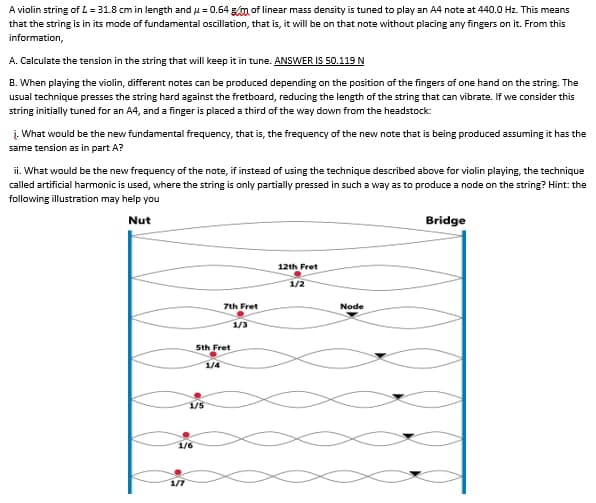A violin string of L = 318 cm in length and u = 0.64 gim of linear mass density is tuned to play an A4 note at 440.0 Hz. This means that the string is in its mode of fundamental oscillation, that is, it will be on that note without placing any fingers on it. From this information, A. Calculate the tension in the string that will keep it in tune. ANSWER IS 50.119 N B. When playing the violin, different notes can be produced depending on the position of the fingers of one hand on the string The usual technique presses the string hard against the fretboard, reducing the length of the string that can vibrate. If we consider this string initially tuned for an A4, and a finger is placed a third of the way down from the headstock į What would be the new fundamental frequency, that is, the frequency of the new note that is being produced assuming it has the same tension as in part A?
A violin string of L = 318 cm in length and u = 0.64 gim of linear mass density is tuned to play an A4 note at 440.0 Hz. This means that the string is in its mode of fundamental oscillation, that is, it will be on that note without placing any fingers on it. From this information, A. Calculate the tension in the string that will keep it in tune. ANSWER IS 50.119 N B. When playing the violin, different notes can be produced depending on the position of the fingers of one hand on the string The usual technique presses the string hard against the fretboard, reducing the length of the string that can vibrate. If we consider this string initially tuned for an A4, and a finger is placed a third of the way down from the headstock į What would be the new fundamental frequency, that is, the frequency of the new note that is being produced assuming it has the same tension as in part A?
Physics for Scientists and Engineers, Technology Update (No access codes included)
9th Edition
ISBN:9781305116399
Author:Raymond A. Serway, John W. Jewett
Publisher:Raymond A. Serway, John W. Jewett
Chapter17: Sound Waves
Section: Chapter Questions
Problem 17.61AP: To measure her speed, a skydiver carries a buzzer emitting a steady tone at 1 800 Hz. A friend on...
Related questions
Concept explainers
Interference of sound
Seiche
A seiche is an oscillating standing wave in a body of water. The term seiche pronounced saysh) can be understood by the sloshing of water back and forth in a swimming pool. The same phenomenon happens on a much larger scale in vast bodies of water including bays and lakes. A seizure can happen in any enclosed or semi-enclosed body of water.
Question
Solve B 1 and 2 step by step pls !

Transcribed Image Text:A violin string of L= 31.8 cm in length and u = 0.64 g/m of linear mass density is tuned to play an A4 note at 440.0 Hz. This means
that the string is in its mode of fundamental oscillation, that is, it will be on that note without placing any fingers on it. From this
information,
A. Calculate the tension in the string that will keep it in tune. ANSWER IS 50.119 N
B. When playing the violin, different notes can be produced depending on the position of the fingers of one hand on the string. The
usual technique presses the string hard against the fretboard, reducing the length of the string that can vibrate. If we consider this
string initially tuned for an A4, and a finger is placed a third of the way down from the headstock:
į. What would be the new fundamental frequency, that is, the frequency of the new note that is being produced assuming it has the
same tension as in part A?
ii. What would be the new frequency of the note, if instead of using the technique described above for violin playing, the technique
called artificial harmonic is used, where the string is only partially pressed in such a way as to produce a node on the string? Hint: the
following illustration may help you
Nut
Bridge
12th Fret
1/2
7th Fret
Node
1/3
Sth Fret
1/4
1/5
1/6
1/7
Expert Solution
This question has been solved!
Explore an expertly crafted, step-by-step solution for a thorough understanding of key concepts.
Step by step
Solved in 3 steps

Knowledge Booster
Learn more about
Need a deep-dive on the concept behind this application? Look no further. Learn more about this topic, physics and related others by exploring similar questions and additional content below.Recommended textbooks for you

Physics for Scientists and Engineers, Technology …
Physics
ISBN:
9781305116399
Author:
Raymond A. Serway, John W. Jewett
Publisher:
Cengage Learning

Physics for Scientists and Engineers: Foundations…
Physics
ISBN:
9781133939146
Author:
Katz, Debora M.
Publisher:
Cengage Learning

Principles of Physics: A Calculus-Based Text
Physics
ISBN:
9781133104261
Author:
Raymond A. Serway, John W. Jewett
Publisher:
Cengage Learning

Physics for Scientists and Engineers, Technology …
Physics
ISBN:
9781305116399
Author:
Raymond A. Serway, John W. Jewett
Publisher:
Cengage Learning

Physics for Scientists and Engineers: Foundations…
Physics
ISBN:
9781133939146
Author:
Katz, Debora M.
Publisher:
Cengage Learning

Principles of Physics: A Calculus-Based Text
Physics
ISBN:
9781133104261
Author:
Raymond A. Serway, John W. Jewett
Publisher:
Cengage Learning

Physics for Scientists and Engineers with Modern …
Physics
ISBN:
9781337553292
Author:
Raymond A. Serway, John W. Jewett
Publisher:
Cengage Learning

Physics for Scientists and Engineers
Physics
ISBN:
9781337553278
Author:
Raymond A. Serway, John W. Jewett
Publisher:
Cengage Learning

University Physics Volume 1
Physics
ISBN:
9781938168277
Author:
William Moebs, Samuel J. Ling, Jeff Sanny
Publisher:
OpenStax - Rice University